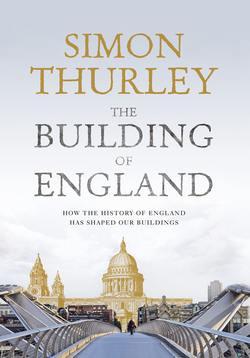Читать книгу The Building of England: How the History of England Has Shaped Our Buildings - Simon Thurley - Страница 15
The Mercian Kingdom
ОглавлениеIn the 8th century the kingdom of Mercia was dominated by two very powerful and successful kings who controlled most of England south of the River Humber. Ethelbald (716–57) and Offa (757–96) were the first kings able to organise huge labour forces to solve surveying, engineering and construction problems on a national scale. Ethelbald was probably responsible for starting a concerted programme of bridge and road building to improve communications. No Anglo-Saxon bridge now survives – most were probably of timber – but before 1000 a network of bridges carried roads on both local and national routes.3
Offa is of particular importance as an international figure who corresponded with Charlemagne and was a friend of Pope Hadrian. He is also significant as the builder of Britain’s largest monument: the 150-mile-long Offa’s Dyke (fig. 13). The dyke was probably constructed to keep Welsh raiders out of Mercia and had 6ft-deep ditches with a 25ft bank behind; the rampart was topped by timber palisading and, in places, stone walls. Offa was able to mobilise labour for this and for the fortification of towns, marking a major change in the way England’s landscape was moulded by the power of the state. Offa’s achievements in church building were no less impressive, if only fragments of his churches now survive. Much to the chagrin of Canterbury, Offa used his influence with the Pope to found a new archiepiscopal see at Lichfield. Nothing of Offa’s cathedral remains except for a fragment of a contemporary shrine chest associated with the cult of St Chad (fig. 14). This carving, one of the most beautiful and moving to survive from Saxon England, reveals Mercian carvers following Carolingian fashions, reviving the sculptural style of the early Christian Church.4
Fig. 14 The corner of a tomb chest of c.800, probably from the shrine of St Chad, who died in 672. This fragment, found in 2003, shows that Mercian sculptors and architects, like their continental counterparts, were reviving late Roman styles.
Fig. 15 St Wystan’s, Repton, Derbyshire. The mausoleum of King Wiglaf of c.830. This compact but richly articulated space contained recesses to take the tombs of the Mercian royal family.
An even more potent expression of Mercian interest in early Roman Christianity is their royal mausoleum at Repton, Derbyshire. The crypt here was first built as a freestanding burial chamber for the kings of Mercia. King Wiglaf, before his death in 839, transformed the chamber from a plain rectangular cellar into a spectacular mausoleum by incorporating it into the chancel of the church and building an internal vault supported by four twisted stone columns based on the most prestigious late Roman Christian monument in Rome: the tomb of St Peter. This daring allusion gave voice to the power of Mercian kings in the language of Carolingian Europe (fig. 15).
More substantial evidence of the Mercian revival of Rome is the church of All Saints’, Brixworth, England’s most exciting and impressive standing Anglo-Saxon building (fig. 16). The church is big, about 160ft in length, but is now shorn of its ‘porticuses’, five on each side, which originally flanked the open hall of the nave, rather like aisles in later churches, but subdivided into individual chambers. East of the nave was a separate space, a choir, enclosed by an apsidal sanctuary beneath which was a crypt encircled by an enclosed passageway.5 The nave arcades are truly massive, their voussoirs made of reused Roman brick; whoever commissioned and designed this church was deliberately and successfully recreating a sense of Roman monumentality, and might have known contemporary Carolingian buildings.6
How many such churches existed in Mercia or elsewhere before the Vikings is quite unclear, but it is unlikely that Brixworth, and the major minster excavated at Cirencester, Gloucestershire, were the only two. These structures put architecture in England in the 8th and 9th centuries in the same bracket as some of the most avant-garde structures in Europe.
Fig. 16 All Saints’, Brixworth, Northamptonshire. This powerful church (the largest surviving Anglo-Saxon church in England) would have been even more massive before the demolition of its porticuses. The blocked-up ground floor arches along the nave would have originally led into these, just as at St Peter’s, Wearmouth (as shown in fig. 8). The tower with its semi-circular staircase projection is probably 10th century.
